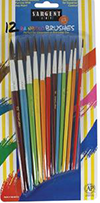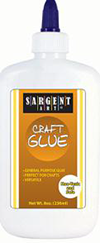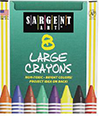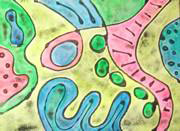What are organic shapes? They generally refer to shapes found in nature – like leaves, clouds, and fruit. Organic shapes that artists draw are usually rounded and/or wavy. The Spanish artist, Joan Miro, was very imaginative, and he created many artworks based on simple organic shapes. Sometimes these shapes are symbolic of people, animals, and images in nature.
Goal (Terminal Objective):
Students will be able to recognize organic shapes in artworks and in nature. They will learn about Joan Miro and be able to distinguish his style of painting.
Objective:
Students will design and paint artworks that develop around the principles and elements of design. Students will learn to draw organic shapes and be able to incorporate them into a balanced composition. They will use white glue as a drawing medium.
National Standards:
Visual Arts Grades K-4 Content Standard 1: Understanding and applying media, techniques, and processes
Visual Arts Grades K-4 Content Standard 3: Choosing and evaluating a range of subject matter, symbols, and ideas
Visual Arts Grades K-4 Content Standard 5: Reflecting upon and assessing the characteristics and merits of their work and the work of others
Visual Arts Grades K-4 Content Standard 6: Making connections between visual arts and other disciplines – science cross curriculum connection
Purpose:
Students will compare geometric and organic shapes. They will look for organic shapes around them. Important works of art by Joan Miro will be introduced. They will connect organic shapes in art to organic shapes found in nature. Students will be able to design and paint original compositions based on organic shapes. They will use non-traditional art tools to draw, including glue and brayers.
New Vocabulary:
Joan Miro, Spain, imagination, organic, symbolize, brayer, composition
Materials:

#56-6012 Natural Hair Rainbow Brush Assortment

#22-1103 Craft Glue

#22-0561 Tuck box large crayons

#22-9803 Large Flat Palette

#66-8222 Art-Time Fluorescent Watercolor Set

#23-5026 25 sheet Watercolor Pad
watercolor paper, black printing ink, and brayers
Time:
3-4 lessons (45 minutes each)
Introduction and Motivation (Set):
- Teacher introduces students to artist, Joan Mio. Students view several of his paintings and discuss the artist’s style. What shapes did he use? What are organic shapes? Can you identify organic shapes in nature? How do his paintings make you feel?
- Teacher shows Spain on a world map. Students are asked to comment on Miro’s style of painting. Do you think the artist could also draw realistic images? Why do you think he liked to paint in this style? Do you think these shapes are meant to symbolize real images?
Instruction:
Lesson 1:
Teacher presents paintings by Joan Miro. Introduction includes group discussion about the artist and his life. Students look at the artist’s style of composing his paintings. What art materials did he use? What colors did he use? Did he like to use organic shapes? Are any of his shapes symbolic of real images? Teacher introduces the Elements of Design, focusing on line, shape, and composition. Students look at teacher exemplars. Teacher helps students trace a 9” x 12” rectangle on the water color paper. (Painting within the 9’ x 12” space will prevent the water color paper from curling. Upon completion, the border will be trimmed.) After teacher demonstrates, students use black crayons to draw a balanced composition with organic shapes.

Lesson 2:
Teacher demonstrates drawing with glue. Students carefully outline their line designs from Lesson 1 with glue (dry overnight).

Lesson 3:
Teacher demonstrates painting with fluorescent water colors. Students carefully paint the sections of their designs. The glue lines will prevent the paint from spreading into other sections (dry overnight).

Lesson 4:
Teacher demonstrates applying printing ink onto a brayer and quickly/lightly rolling over the entire painting. The glue lines will now be black and the painted sections will have black highlights. Students apply printing ink to their paintings.

Activities:
(1) Guided Practice:
- Students learn about Joan Miro and discuss his style of art. Students watch teacher’s step-by-step demonstrations and discuss teacher exemplars.
- Students create paintings in the style of Miro using Sargent Art water color paints, paint brushes, crayons, and glue. (Clean up with soap and water. Storage on drying racks.)
(2) Independent Practice and Check for Understanding:
- Teacher circulates through the room during student work time, answering questions and offering support as needed.
- Teacher notes students’ understanding of directions and reviews them with the class if necessary.
(3) Closure:
- Students show their paintings to the class and tell what they learned about Miro and imaginative organic shapes. They discuss how organic shapes can sometimes symbolize people, animals, and images in nature.
- Students discuss the importance of respect for individuality.
Evaluation:
Level One — The artwork conveys the style of Miro. Student drew very original organic shapes. Composition is balanced with a variety of shapes and colors. Craftsmanship is excellent. Student handles materials with confidence. Student can identify organic shapes in nature.
Level Two — The artwork conveys the style of Miro. Student drew original organic shapes. Composition is balanced with a variety of shapes and colors. Craftsmanship is good. Student handles most materials with confidence. Student can identify organic shapes in nature.
Level Three — The student has made an effort to convey the style of Miro. Student did not draw original organic shapes. Composition is somewhat balanced with shapes and colors. Craftsmanship is fair. Student handles materials with varied confidence. Student can identify some organic shapes in nature.
Level Four — The artwork does not convey the style of Miro. Student did not attempt to draw organic shapes. Composition is not balanced with a variety of shapes and colors. Craftsmanship is poor. Student needs much support in handling material. Student cannot identify organic shapes in nature.
Extension:
Students can use teacher-created coloring page, adding additional lines to make a Miro-like landscape with people and/or animals. Use Sargent Art crayons to color.

Resources:
http://www.es-cat.org/~rclarkinia/pdfs/design_principles.pdf (principles of design)
http://www.artsconnected.org/toolkit/encyc_shapegeorganic.html
http://en.wikipedia.org/wiki/Joan_Miro
http://www.mcs.csuhayward.edu/~malek/Miro.html
http://www.artnet.com/Artists/ArtistHomePage.aspx?artist_id=675008&page_tab=Artwo rks_for_sale
http://fte.eanes.k12.tx.us/Gallery%20Greats/miro.htm
Miro’s paintings
http://www.poster.net/miro-joan/miro-joan-painting-7600224.jpg
(Painting)
http://static.flickr.com/161/432737841_34271c76ac.jpg
(Hirondelle Amour)
http://www.poster.net/miro-joan/miro-joan-upside-down-figures-5300080.jpg
(People and Dog in Sun)
Art Consultant



